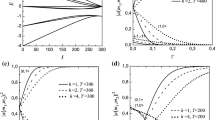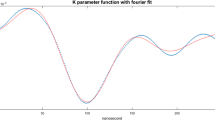Abstract
We present a quantum neural network with multi-neuron interactions for pattern recognition tasks by a combination of extended classic Hopfield network and adiabatic quantum computation. This scheme can be used as an associative memory to retrieve partial patterns with any number of unknown bits. Also, we propose a preprocessing approach to classifying the pattern space S to suppress spurious patterns. The results of pattern clustering show that for pattern association, the number of weights (\(\eta \)) should equal the numbers of unknown bits in the input pattern (d). It is also remarkable that associative memory function depends on the location of unknown bits apart from the d and load parameter \(\alpha \).



Similar content being viewed by others
Notes
This formula is obtained from permutation of pairwise interacted neuron in each model, for \(N>3\) and \(d>2\).
References
Yegnanarayana, B.: Artificial Neural Networks, pp. 77–87. PHI Learning Pvt. Ltd, New Delhi (2009)
Hopfield, J.J.: Neural networks and physical systems with emergent collective computational abilities. Proc. Natl. Acad. Sci. 79(8), 2554–2558 (1982)
Hagan, M.T., Demuth, H.B., Beale, M.H., Jesus, O.D.: Neural Network Design, 2nd edn, Martin Hagan, chap. 21, p. 16 (2014)
Bruck, J., Roychowdhury, V.P.: On the number of spurious memories in the Hopfield model (neural network). IEEE Trans. Inf. Theory 36(2), 393–397 (1990)
Hopfield, J.J., Feinstein, D.I., Palmer, R.G.: “Unlearning” has a stabilizing effect in collective memories. Nature 304, 158–159 (1983)
Amit, D.J., Gutfreund, H., Sompolinsky, H.: Spin-glass models of neural networks. Phys. Rev. A 32(2), 1007 (1985)
Amit, D.J., Gutfreund, H., Sompolinsky, H.: Storing infinite numbers of patterns in a spin-glass model of neural networks. Phys. Rev. Lett. 55(14), 1530 (1985)
Amit, D.J., Gutfreund, H., Sompolinsky, H.: Information storage in neural networks with low levels of activity. Phys. Rev. A 35(5), 2293 (1987)
Morita, M.: Associative memory with nonmonotone dynamics. Neural Netw. 6(1), 115–126 (1993)
Nishikawa, T., Lai, Y.C., Hoppensteadt, F.C.: Capacity of oscillatory associative-memory networks with error-free retrieval. Phys. Rev. Lett. 92(10), 108101 (2004)
Amari, S.I., Maginu, K.: Statistical neurodynamics of associative memory. Neural Netw. 1(1), 63–73 (1988)
Okada, M.: A hierarchy of macrodynamical equations for associative memory. Neural Netw. 8(6), 833–838 (1995)
Coolen, A.C.C., Sherrington, D.: Order-parameter flow in the fully connected Hopfield model near saturation. Phys. Rev. E 49(3), 1921 (1994)
Coolen, A.C.C., Laughton, S.N., Sherrington, D.: Dynamical replica theory for disordered spin systems. Phys. Rev. B 53(13), 8184 (1996)
Ma, Y.Q.: Statics in the random quantum asymmetric Sherrington–Kirkpatrick model. Phys. Rev. B 45(2), 793 (1992)
Xi, Q., Ma, Y.Q.: Quantum Hopfield model with a random transverse field and a random neuronal threshold. Phys. Lett. A 254(6), 355–360 (1999). Vancouver
Nishimori, H., Nonomura, Y.: Quantum effects in neural networks. J. Phys. Soc. Jpn. 65(12), 3780–3796 (1996)
Inoue, J.I.: Pattern-recalling processes in quantum Hopfield networks far from saturation. J. Phys. Conf. Ser. 297(1), 012012 (2011)
Suzuki, M.: Relationship between d-dimensional quantal spin systems and (\(d+1\))-dimensional Ising systems: equivalence, critical exponents and systematic approximants of the partition function and spin correlations. Progress of theoretical physics 56(5), 1454–1469 (1976)
Farhi, E., Goldstone, J., Gutmann, S., Lapan, J., Lundgren, A., Preda, D.: A quantum adiabatic evolution algorithm applied to random instances of an NP-complete problem. Science 292(5516), 472–475 (2001)
Santra, S., Quiroz, G., Ver Steeg, G., Lidar, D.A.: MAX 2-SAT with up to 108 qubits. New J. Phys. 16(4), 045006 (2014)
Aharonov, D., Van Dam, W., Kempe, J., Landau, Z., Lloyd, S., Regev, O.: Adiabatic quantum computation is equivalent to standard quantum computation. In: Proceedings of the 45th Annual Symposium on the Foundations of Computer Science, 2004, Rome, Italy IEEE Computer Society Press, New York, p. 4251 (2004)
Das, S., Kobes, R., Kunstatter, G.: Adiabatic quantum computation and Deutschs algorithm. Phys. Rev. A 65(6), 062310 (2002)
Wei, Z., Ying, M.: A modified quantum adiabatic evolution for the Deutsch–Jozsa problem. Phys. Lett. A 354(4), 271–273 (2006)
Roland, J., Cerf, N.J.: Quantum search by local adiabatic evolution. Phys. Rev. A 65(4), 042308 (2002)
Hen, I.: Period finding with adiabatic quantum computation. EPL Europhys. Lett. 105(5), 50005 (2014)
Santra, S., Shehab, O., Balu, R.: Exponential capacity of associative memories under quantum annealing recall. arXiv preprint arXiv:1602.08149 (2016)
Seddiqi, H., Humble, T.S.: Adiabatic quantum optimization for associative memory recall. arXiv preprint arXiv:1407.1904 (2014)
Seki, Y., Nishimori, H.: Quantum annealing with antiferromagnetic transverse interactions for the Hopfield model. J. Phys. A Math. Theor. 48(33), 335301 (2015)
Neigovzen, R., Neves, J.L., Sollacher, R., Glaser, S.J.: Quantum pattern recognition with liquid-state nuclear magnetic resonance. Phys. Rev. A 79(4), 042321 (2009)
Fard, E.R., Aghayar, K.: Quantum adiabatic evolution for pattern recognition problem. Chin. Phys. Lett. 34(12), 120302 (2017)
Wittek, P.: Quantum Machine Learning: What Quantum Computing Means to Data Mining, pp. 116–117. Academic Press, New York (2014)
Gardner, E.: Multiconnected neural network models. J. Phys. A Math. Gen. 20(11), 3453 (1987)
Hebb, D.O.: The Organization of Behavior: A Neuropsychological Theory. Psychology Press, London (2005)
McEliece, R., Posner, E., Rodemich, E., Venkatesh, S.: The capacity of the Hopfield associative memory. IEEE Trans. Inf. Theory 33(4), 461–482 (1987)
Gardner, E.: Spin glasses with p-spin interactions. Nucl. Phys. B 257, 747–765 (1985)
Gross, D.J., Mzard, M.: The simplest spin glass. Nucl. Phys. B 240(4), 431–452 (1984)
Farhi, E., Goldstone, J., Gutmann, S., Sipser, M.: Quantum computation by adiabatic evolution. arXiv preprint arXiv:quant-ph/0001106 (2000)
Born, M., Fock, V.: Beweis des adiabatensatzes. Z. Phys. Hadrons Nucl. 51(3), 165–180 (1928)
Zhang, D.J., Yu, X.D., Tong, D.M.: Theorem on the existence of a nonzero energy gap in adiabatic quantum computation. Phys. Rev. A 90(4), 042321 (2014)
Albash, T., Lidar, D.A.: Adiabatic quantum computing. arXiv preprint arXiv:1611.04471 (2016)
McMahon, D.: Quantum Computing Explained, John Wiley & Sons, pp. 305–313 (2007)
Nielsen, M.A., Chuang, I.L.: Quantum Computation and Quantum Information, 1st edn. Cambridge University Press, Cambridge (2002)
Choi, V.: Minor-embedding in adiabatic quantum computation: II. Minor-universal graph design. Quantum Inf. Process. 10(3), 343–353 (2011)
Hen, I., Young, A.P.: Exponential complexity of the quantum adiabatic algorithm for certain satisfiability problems. Phys. Rev. E 84, 061152 (2011)
Childs, A.M., Farhi, E., Preskill, J.: Robustness of adiabatic quantum computation. Phys. Rev. A 65(1), 012322 (2001)
Roland, J., Cerf, N.J.: Noise resistance of adiabatic quantum computation using random matrix theory. Phys. Rev. A 71(3), 032330 (2005)
Author information
Authors and Affiliations
Corresponding author
Adiabatic condition of QNN
Adiabatic condition of QNN
The behavior of the QNN depends on runtime AQC. Here, we calculate numerically runtime of the algorithm with high probability in two broad case. Previously, the runtime of AQC for the two-qubit neural network [30] has been calculated analytically for recalling pattern process and pattern association separately in more details [31].
1.1 Runtime of AQC for pattern recalling process
Let us consider Hamiltonian (19) belong to Sect. 4.1 for recalling patterns from the memory of QNN. To do this work, the time-dependent Hamiltonian (8) by defining a dimensionless quantities \(s=\frac{t}{T}\) can be written as
As an instance, suppose the patterns into the first cluster (\(S_1\)) with \(J=1\) load in the memory and the input pattern (\(\xi ^{\mathrm{inp}}\)) and \(\Gamma \) are \((1,1,1,1)^t\) and 1 / 2 respectively so as H(t) would be
The eigenvalues and eigenstates of H(t) may be achieved analytically, but here we only focus on calculation of \(g_{\min }\) and \(D_{\max }\) numerically. Therefore, we draw all eigenvalues of H(t) in Fig. 4 and find two lowest eigenvalues of H(t). Then, we define two quantity \(g(s)=E_1(s)-E_0(s)\) and \(D(s)=\langle E_1|\frac{\mathrm{d}H(s)}{\mathrm{d}t}|E_0\rangle =\frac{1}{T}\langle E_1|\frac{\mathrm{d}H(s)}{\mathrm{d}s}|E_0\rangle \) to calculate adiabatic condition (11). The minimum of g(s) occur at \(s=0.381607\)
and the maximum value of \(\big |\big \langle \frac{\mathrm{d}H(s)}{\mathrm{d}s}\big \rangle \big |\) is attained as follows
Now we can determine lower bound of runtime for AQC form Eq. (11)
which gives an estimate of the time to evolve \(|\psi _0\rangle \) via adiabatic Hamiltonian (8) to attain an accuracy of order \(\varepsilon \) of the final result. As an example, for accuracy of \( \%90\), the lower bound of runtime should be on the order of
in units of \(\bar{T}\). Although this runtime is obtained for the input pattern \((1,1,1,1)^t\), for each pattern in its own subspace is valid.
The \(\Gamma \) coefficient in the classic neural network is called learning rate and interpreted as the association between the stimulus (input) and response (output). By increasing the association between the stimulus and response, the network learns faster than before. The result of minimum evolution time for different Hamiltonian shows that similar to classic network, for the same percent of accuracy of the final state (%90), by decreasing the \(\Gamma \) (decreasing the association) in Eq. (8) \(T_{\mathrm{low}}\) will increase gradually (see Table 7).
The runtime of evolution to recall pattern in Sects. 4.2 and 4.3 is calculated numerically and their result presented in Table 8 for \(\%90\) percent of accuracy.
1.2 Runtime of AQC for partial patterns
In this case, due to the presence of unknown bits in the input pattern, the runtime of AQC is different from previous case. Here, we must repeat all calculation and finally obtain the quantities \(g_{\min }\) and \(D_{\max }\). The numerical results show that the Hamiltonians in Sects. 4.1 and 4.2 for all partial patterns have a specific minimum runtime (see Table 9). But as already outlined in Sect. 4.3, the QNN converges to a superposition state for partial patterns of the fourth model in Fig. 1b. The minimum energy for these patterns is zero, and thus, the quantum system cannot evolve adiabatically (see Fig. 5). Although for other models in Fig. 1b, \(g_{min}\) is nonzero and the quantum system adiabatically evolve which minimum runtime (\(T_{\mathrm{low}}\)) for all partial patterns is 21.769 in units of \(\bar{T}\) for accuracy of \(\%90\) and \(\Gamma =1/2\).
Rights and permissions
About this article
Cite this article
Fard, E.R., Aghayar, K. & Amniat-Talab, M. Quantum pattern recognition with multi-neuron interactions. Quantum Inf Process 17, 42 (2018). https://doi.org/10.1007/s11128-018-1816-y
Received:
Accepted:
Published:
DOI: https://doi.org/10.1007/s11128-018-1816-y






